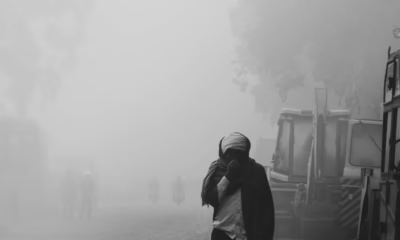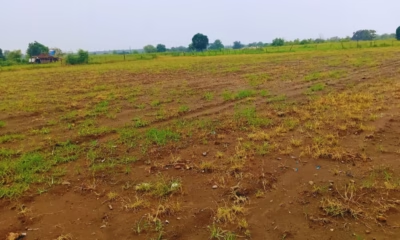COP30
Air Pollution Claimed 1.7 Million Indian Lives and 9.5% of GDP, Finds The Lancet
In 2022 alone, fine particulate pollution — PM2.5 — killed an estimated 1.7 million people in India, according to the Lancet Countdown on Health and Climate Change 2025.
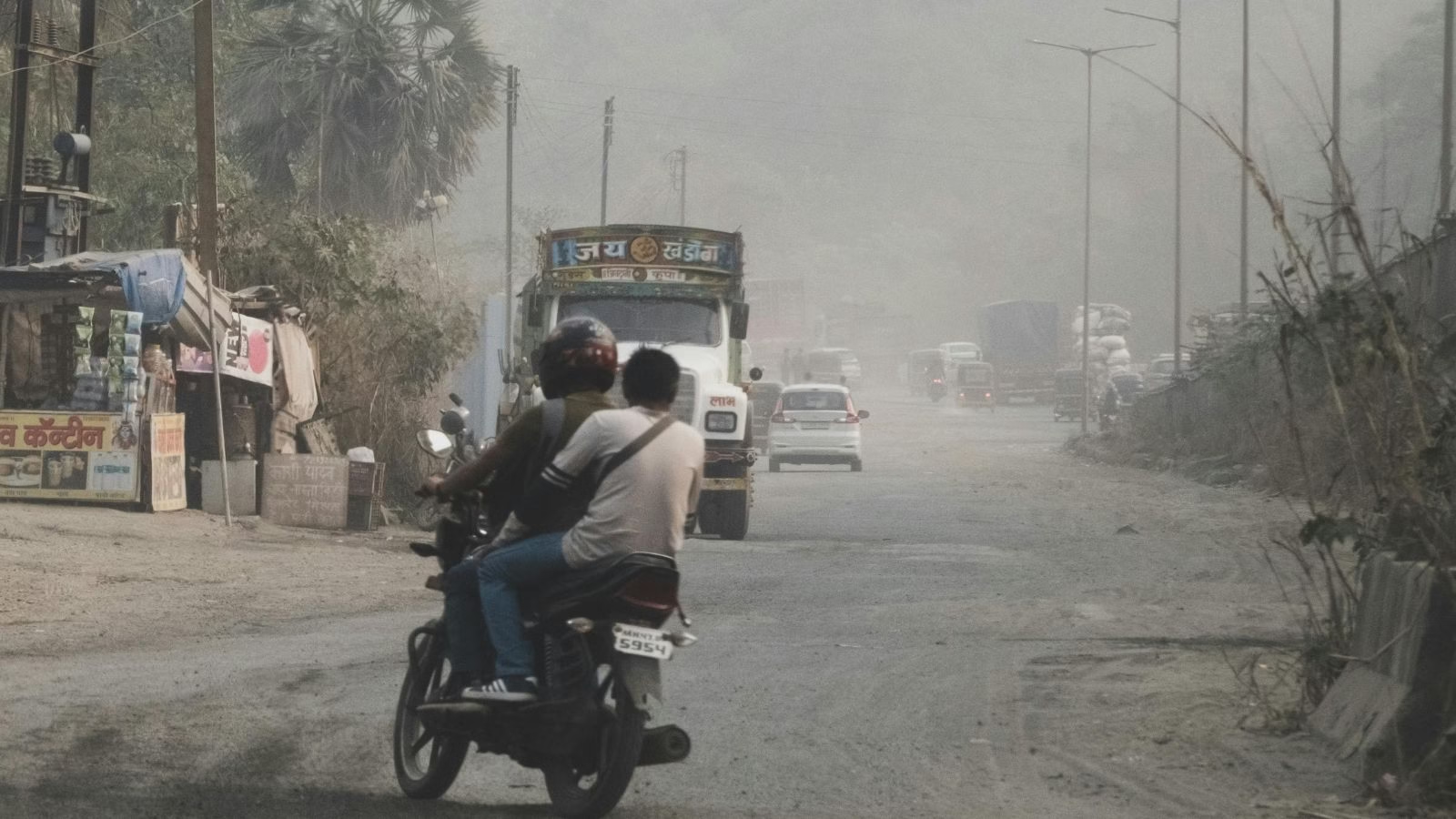
In 2022 alone, fine particulate pollution — PM2.5 — killed an estimated 1.7 million people in India, according to the Lancet Countdown on Health and Climate Change 2025.
The same toxic particles that fill Delhi’s winter air and blanket cities from Kanpur to Kolkata also caused economic losses equivalent to 9.5% of India’s GDP, revealing that air pollution is not just a public health emergency, but a national economic crisis hiding in plain sight.
A Crisis Woven into Everyday Life
India’s worsening air quality is no longer a seasonal problem. According to The Lancet Countdown, over a third of Indians were exposed to PM2.5 levels exceeding World Health Organization (WHO) limits for more than 10 months of the year.
Rising temperatures, urban sprawl, and fossil fuel combustion — from coal-fired power plants to vehicle emissions — have created a deadly feedback loop that is choking the country’s lungs and its economy.
“Air pollution in India is a silent pandemic. It’s not only shortening lives, but undermining productivity, healthcare systems, and economic growth,” said Dr. Marina Romanello, Executive Director of The Lancet Countdown, in the report’s global launch statement.
The Health Toll: From Newborns to the Elderly
The Lancet Countdown 2025 estimates that the global death toll from air pollution reached 8.3 million in 2022, with India accounting for over one-fifth of those fatalities.
PM2.5 — particles less than 2.5 microns in diameter — penetrate deep into lungs and bloodstreams, causing or worsening heart disease, stroke, diabetes, and respiratory illness.
In India, the burden falls disproportionately on the poorest households, who are more likely to live near highways, coal plants, or industrial clusters and have limited access to healthcare.
Children and elderly people are the most vulnerable: the report highlights that exposure to dirty air increases the risk of low birth weight, premature births, and chronic illness later in life.
Counting the Cost: 9.5% of GDP Lost
The Lancet Countdown’s economic assessment, based on lost labour productivity, healthcare costs, and premature deaths, found that India lost 9.5% of its GDP in 2022 due to air pollution-related impacts.
That’s roughly equivalent to USD 300 billion — more than India’s entire annual education and health budgets combined.
Urban centres such as Delhi, Lucknow, and Patna rank among the most polluted in the world.
Air pollution is estimated to reduce life expectancy in northern India by up to 7 years, according to the Energy Policy Institute at the University of Chicago, underscoring how pervasive the damage has become.
“For a fast-growing economy like India, this is a double blow,” said Prof. Randeep Guleria, pulmonologist and former AIIMS director. “It burdens healthcare systems while reducing worker output — exactly the opposite of what a young nation needs.”
Climate and Air: The Same Enemy
The report connects India’s pollution crisis to its dependence on fossil fuels — especially coal — which remains the largest source of both CO₂ and PM2.5 emissions.
While government programmes such as the National Clean Air Programme (NCAP) and electric mobility initiatives aim to reduce pollution, progress has been slow.
Many of the dirtiest thermal plants continue to operate without meeting emission standards, and vehicle emissions remain poorly regulated outside major cities.
“Air pollution is not a separate problem from climate change — it’s the same story told through different symptoms,” noted Dr. Romanello. “Every tonne of coal burned harms both lungs and the climate.”
This linkage is echoed in India’s own National Electricity Plan 2032, which outlines aggressive renewable targets, and in Ember’s 2025 analysis, which found that expanding coal capacity further would be economically irrational — a finding that strengthens the case for rapid decarbonisation.
Health as an Economic Argument
The Lancet Countdown reframes pollution not just as an environmental or health challenge, but as an economic imperative.
In India, labour losses due to heat and pollution exposure have grown by 42% since the early 2000s, with outdoor and informal workers suffering the most.
As heatwaves and smog increasingly overlap, lost work hours and rising healthcare costs could slow GDP growth by up to 1.8 percentage points annually by the mid-2030s if left unchecked.
Experts say cleaner power and transport sectors could deliver rapid wins:
- Phasing out coal and shifting to renewables can cut PM2.5 emissions by over 60% in key industrial zones.
- Expanding public transit and EV adoption can reduce vehicular PM2.5 by one-third in metropolitan regions.
- Strengthening NCAP’s monitoring and enforcement could save hundreds of thousands of lives each year.
From Policy to Breathable Air
Despite India’s national clean air mission and renewable push, enforcement and coordination remain major gaps.
The report calls for integrating air quality and climate policies, arguing that cutting fossil fuel use provides a “double dividend” — cleaner air and fewer greenhouse gases.
This integration has begun in limited form: several Indian states, including Gujarat and Maharashtra, have introduced emissions trading schemes for industrial pollutants.
But experts say scaling such initiatives nationally, alongside stricter vehicle standards and urban planning reforms, is critical for measurable results.
A Moment of Reckoning
The Lancet Countdown 2025 warns that air pollution and climate impacts are already reversing health gains made over decades.
India’s choice is no longer between growth and clean air — it’s about whether growth can continue at all under the weight of rising illness, lost labour, and degraded ecosystems.
“Air pollution is robbing India of its demographic dividend,” the report concludes. “Clean air is not a luxury; it’s a prerequisite for sustainable development.”
As the smog season begins once again in northern India, the data are unambiguous:
The invisible killer is now visible — and unaffordable.
References:
The Lancet Countdown on Health and Climate Change 2025; The Lancet; Energy Policy Institute at the University of Chicago (EPIC); Ember; CREA.
COP30
Farmers Warn: The World Needs $443 Billion a Year to Protect Those Feeding Half of Humanity
A new global report reveals smallholder farmers need $443 billion annually to adapt to climate change—less than today’s harmful farm subsidies. As COP30 nears, farmer groups demand direct funding for resilience.
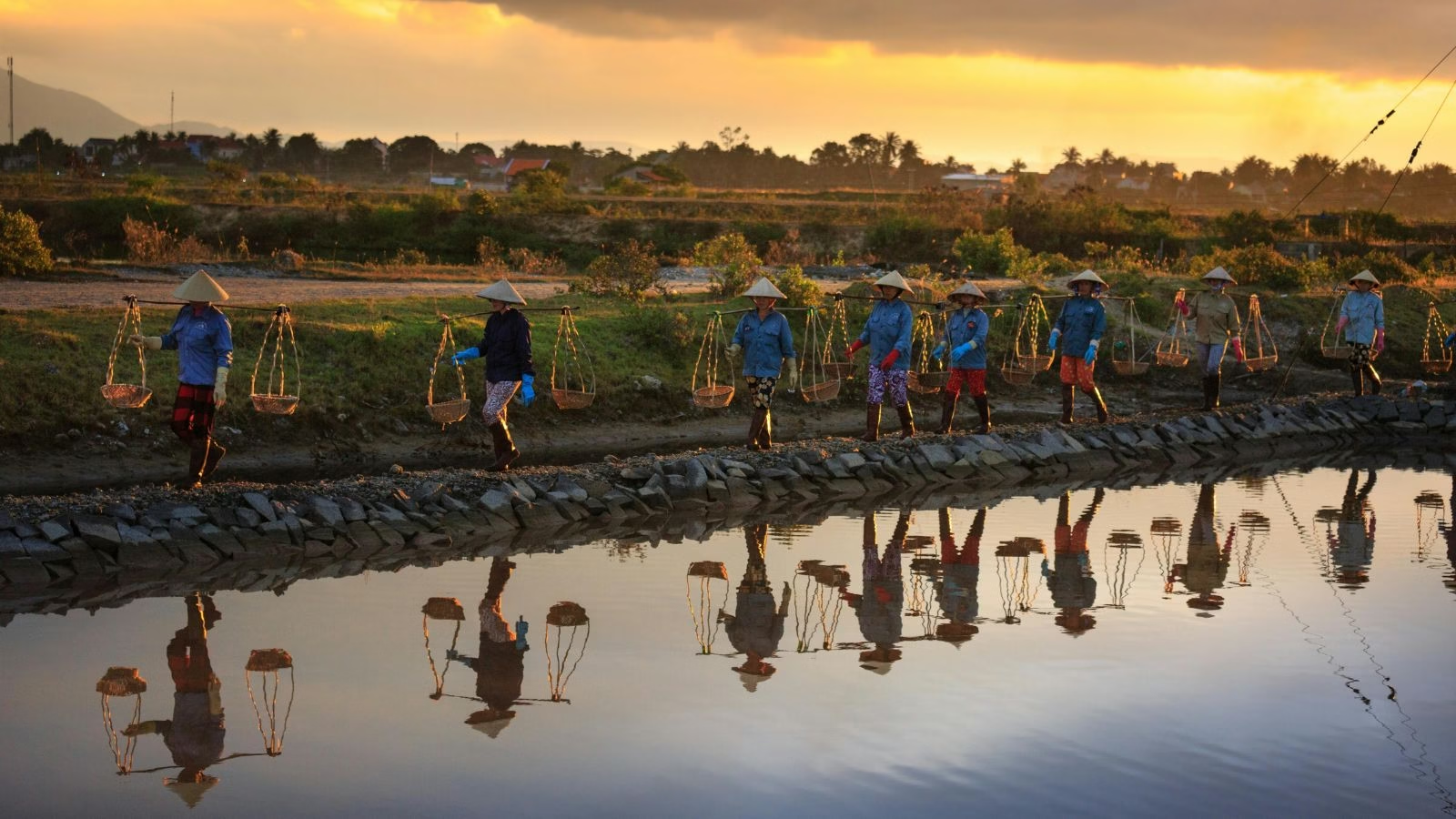
A new global analysis released ahead of COP30 warns that the world must mobilize at least US$443 billion each year to help smallholder farmers adapt to worsening climate impacts—nearly the same amount currently spent on subsidies that harm both people and the planet.
The report, released by Climate Focus for the Family Farmers for Climate Action (FFCA)—an alliance representing 95 million small-scale producers worldwide—reveals that only 0.36% of needed funds currently reach these farmers.
Smallholders, who farm less than 10 hectares each, produce half of the world’s food calories and sustain 2.5 billion livelihoods, yet face rising threats from droughts, floods, and storms. “This isn’t charity—it’s an investment in global food security,” said Elizabeth Nsimadala, President of the Eastern Africa Farmers Federation.
The Cost of Survival: Less Than a Daily Coffee
According to the report, the annual adaptation cost for a typical one-hectare farm is just US$953—or about US$2.19 a day—less than the price of a cup of coffee in Germany. Meanwhile, smallholders already spend 20–40% of their income on adaptation measures, totaling US$368 billion a year from their own pockets.
Investments would support vital measures like micro-irrigation systems, early warning networks, and climate-resilient seeds—steps proven to prevent devastation from saltwater intrusion in Vietnam’s Mekong Delta or drought crises across East Africa.
Dangerous Finance Gaps Leave Farmers Defenseless
Despite their crucial role, current global spending on smallholder adaptation reached only US$1.59 billion in 2021, a drop in the ocean compared to the estimated need. Bureaucratic barriers, limited access to rural banking, and restrictive loan conditions mean that small-scale farmers are frequently shut out of official climate finance systems.
A study cited in the report found that none of the 40 major GEF or GCF projects designed to assist small-scale producers sent funds directly to family farmers. Instead, farmers often rely on informal credit sources with crushing interest rates.
COP30: A Turning Point for Climate Justice
As the upcoming COP30 in Brazil puts adaptation at the centre of global negotiations, farmer-led groups are demanding a dedicated “Farmers Resiliency Fund” to ensure money flows directly to those growing the world’s food.
The Brazilian Presidency’s Action Agenda—which emphasizes sustainable agriculture and hunger eradication—has given hope for reform. However, questions remain over whether rich nations will double adaptation finance to US$40 billion by 2025 or commit to a long-term goal that includes
COP30
Earth Nears Dangerous Tipping Points Amid Rapid Warming, Urgent Action Needed at COP30
The Global Tipping Points Report 2025 warns of imminent climate tipping risks at 1.5°C warming, urging urgent global action at COP30 to prevent irreversible impacts and accelerate sustainable transitions.

As global warming edges perilously close to the 1.5°C threshold, a new scientific report warns that Earth’s vital ecosystems are approaching irreversible tipping points with catastrophic implications for billions of people worldwide. Released ahead of the COP30 climate summit in Belém, Brazil, the ‘Global Tipping Points Report 2025‘ issued by leading researchers from the University of Exeter and international partners reveals an urgent call for unprecedented global cooperation to prevent cascading system collapses.
“Already at 1.4°C of global warming, coral reefs face unprecedented dieback, while polar ice sheets threaten multi-metre sea level rise,” states the report. “The Amazon rainforest risks widespread dieback below 2°C, jeopardizing biodiversity and the livelihoods of over 100 million people.” The report highlights the intertwining threats posed by climate change, deforestation, and feedback loops that amplify warming risks, including potential collapse of the Atlantic Ocean circulation that governs weather patterns across Europe and Africa.
Urgency is paramount. The report emphasizes that exceeding 1.5°C—even briefly—significantly increases the odds of triggering multiple tipping points with cascading effects that disrupt food security, water availability, and economic stability globally. Authors warn that waiting until tipping points are crossed before acting is a grave mistake; instead, immediate measures to halve global greenhouse gas emissions by 2030 and achieve net zero by 2050 are essential.
The report also highlights emerging positive tipping points fueled by rapid adoption of solar power, electric vehicles, and nature-positive initiatives as crucial leverage points for accelerating sustainable transformation. “Positive tipping points can cascade across sectors, driving exponential change,” the researchers note, urging coherent policy mandates, finance mobilization, and inclusive governance to unleash these potentials.
In a message from Brazil, host of COP30, the report’s foreword calls for shifting the narrative from fear to hope: “We must prevent irreversible harm but equally trigger positive tipping points that propel societies towards low-carbon and climate-resilient development.” This vision centers the Global South’s pioneering efforts in regenerative agriculture, forest restoration, and climate finance innovation.
Critical governance challenges remain as the report stresses the need for anticipatory, justice-centered, multi-scale approaches linking human rights with climate action. International cooperation, transparent monitoring, and empowering Indigenous peoples and local communities stand out as pillars to navigate this precarious climate crossroads.
COP30 represents a decisive moment. The report concludes, “The time to act is now. United, we can reverse dangerous climate trajectories and trigger a global wave of renewal. Let us change by choice, together.”
COP30
Bridging the Adaptation Finance Gap: India’s Case Before COP30
As COP30 approaches, India faces a widening adaptation finance gap, despite rising climate impacts and mounting economic losses
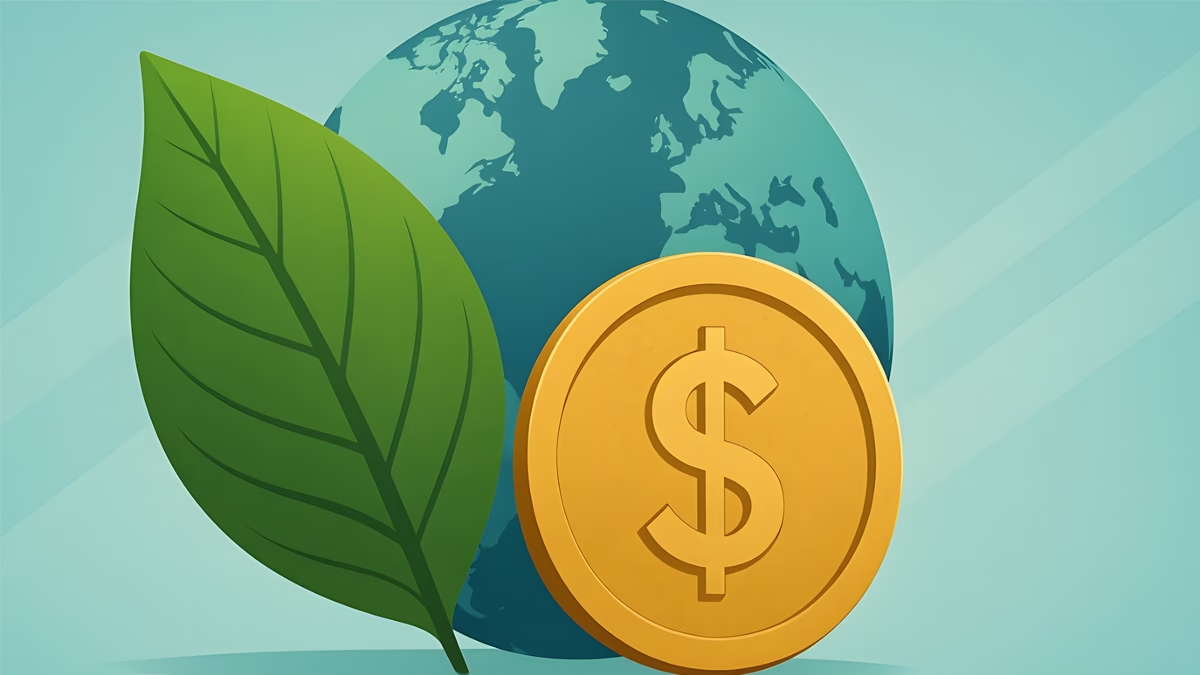
With COP30 in Brazil less than a month away, the world’s attention is turning to the elusive promise of adaptation finance — money meant not for cutting emissions, but for surviving their consequences. In New Delhi this week, a closed-door High-Level Roundtable on Adaptation Finance, organised by Climate Trends, brought together senior policymakers, economists, and global climate finance experts. The message that emerged was stark: India’s adaptation needs are vast, but the money isn’t flowing.
According to international estimates, while adaptation finance globally rose from USD 22 billion to USD 28 billion in 2022, developing countries require more than USD 350 billion annually to protect lives and livelihoods. India’s share of that unmet need remains enormous — and more than 60% of global adaptation finance still comes as loans, piling additional debt on already stressed economies.
“The geopolitics of the world is at an inflection point,” said Aarti Khosla, Director of Climate Trends. “Countries are wrestling with how to make the Global Goal on Adaptation practical and measurable. India is preparing to submit its first National Adaptation Plan. The quality of the finance also matters — because commitments made at multilateral fora are only as good as the systems that deliver them.”
The Growing Cost of Climate Impacts
India’s climate vulnerabilities are intensifying. Record-breaking heatwaves, erratic monsoons, floods, and agricultural losses have already dented GDP growth, with studies suggesting climate-linked economic damage could shave off 2–3% of India’s GDP by 2030. The country’s adaptation costs, as projected by several national and international assessments, could run into tens of billions annually.
Yet, domestic and international systems remain mismatched to that reality. “Adaptation needs to be built into a profitable market system that attracts private investment and creates entrepreneurial enterprise,” argued Abhishek Acharya, Director at the Ministry of Environment, Forest and Climate Change (MoEFCC). “We need a strong policy framework that enables even the last tier of governance — municipalities, panchayats — to access funding.”
The challenge, experts noted, isn’t just about the quantum of funds, but their design. India’s adaptation funding is fragmented across ministries and states, with little clarity on effectiveness. “We should be looking at adaptation-relevant expenditures,” said Amrita Goldar, Senior Fellow at the Indian Council for Research on International Economic Relations (ICRIER). “Looking through budgets at both central and state levels is a big task by itself. For adaptation, we don’t even have a sense of how technologies will evolve. When technologies are niche, private finance will not lead — public finance must.”
The Global Architecture and Local Realities
The Global Goal on Adaptation (GGA), first established under the Paris Agreement, remains largely conceptual — a vision still waiting for metrics. COP30 could change that, with countries expected to finalise indicators for tracking adaptation progress. Yet, experts warn that measurement alone won’t build resilience.
“If GGA indicators get finalised at COP30, they will become a yardstick for evaluation and performance,” said Pushp Bajaj, Programme Lead at Council on Energy, Environment and Water (CEEW). “But just measuring progress isn’t enough. The connections with real climate challenges must be explicit, and India should take a strong stand.”
For India, where agriculture, water, health, and heat stress are already colliding crises, effective adaptation requires reforming both global finance flows and domestic fiscal systems. Kathryn Miliken, Senior Climate Change Specialist at the Asian Development Bank (ADB), noted that adaptation finance forms only about 10% of total climate finance worldwide. “ADB is aiming for 30% of its portfolio to go toward adaptation,” she said. “But the larger challenge is mainstreaming adaptation into economic planning. It still hangs loosely as a standalone agenda.”
Governance Gaps and Subnational Needs
At the state and district levels, limited financial autonomy has hindered locally relevant adaptation measures. Arjun Dutt of CEEW observed, “Coastal embankments, water shelters — these are public goods. Local authorities are directly involved, but though we have devolution in the Constitution, financial powers have not been devolved.”
Experts argued that subnational access to climate finance — through mechanisms like resilience bonds, blended finance, and state adaptation funds — could be the next big step. “Adaptation is a local issue,” said Amir Bazaz, Head of Infrastructure and Climate at the Indian Institute for Human Settlements (IIHS). “We don’t have the capacity to develop projects that are locally embedded, and resources are insufficient. Investments are largely driven by returns, not resilience.”
The Politics of Adaptation
Beyond numbers, adaptation is deeply political. “We understand the global game of power evolving around energy,” said Ambassador Manjeev S. Puri, Distinguished Fellow at TERI. “It’s time for us to talk about adaptation in a louder manner — both locally and globally. Link adaptation to resilience, and you will find political buy-in.”
Ovais Sarmad, Vice Chair of the Greenhouse Gas Protocol, added a sobering global view: “We’re living in a world that’s moved from VUCA — volatile, uncertain, complex, ambiguous — to BANI — brittle, anxious, non-linear, incomprehensible. India must be actively engaged in discussions at the Standing Committee on Finance. Our position must be clear and people-centred.”
The Standing Committee on Finance (SCF), part of the UNFCCC structure, plays a key role in shaping how climate funds are allocated and monitored — including reforms in Multilateral Development Banks (MDBs). Several participants at the roundtable called for MDBs to increase concessional finance and reduce the loan-heavy structure of current adaptation flows.
Data, Delivery, and Diplomacy
For experts like Purnamita Dasgupta, Head of the Environmental and Resource Economics Unit at the Institute for Economic Growth, the way forward lies in clarity and pragmatism. “We want a lot of things, but we need to split this conversation into high-level messages and those we keep within our borders,” she said. “There’s no case for being overwhelmed. Development is the only solution. We should not wait for a magic number, nor ignore it.”
The final consensus from the roundtable was clear: India’s leadership on adaptation finance will depend on how well it aligns data, policy, and diplomacy. As the country prepares to submit its first National Adaptation Plan (NAP) to the UNFCCC, its approach could influence not just negotiations at COP30, but also how the Global South reframes adaptation as a cornerstone of economic growth.
“Adaptation is no longer a technical footnote to mitigation,” Khosla concluded. “It’s about protecting people, ensuring justice, and redesigning the financial systems that decide who gets to survive the climate crisis — and how.”

 Space & Physics5 months ago
Space & Physics5 months agoIs Time Travel Possible? Exploring the Science Behind the Concept

 Know The Scientist5 months ago
Know The Scientist5 months agoNarlikar – the rare Indian scientist who penned short stories

 Society4 months ago
Society4 months agoShukla is now India’s first astronaut in decades to visit outer space

 Earth5 months ago
Earth5 months agoWorld Environment Day 2025: “Beating plastic pollution”

 Society5 months ago
Society5 months agoAxiom-4 will see an Indian astronaut depart for outer space after 41 years

 The Sciences4 months ago
The Sciences4 months agoHow a Human-Inspired Algorithm Is Revolutionizing Machine Repair Models in the Wake of Global Disruptions

 Space & Physics3 months ago
Space & Physics3 months agoJoint NASA-ISRO radar satellite is the most powerful built to date

 Space & Physics6 months ago
Space & Physics6 months agoMIT Physicists Capture First-Ever Images of Freely Interacting Atoms in Space

